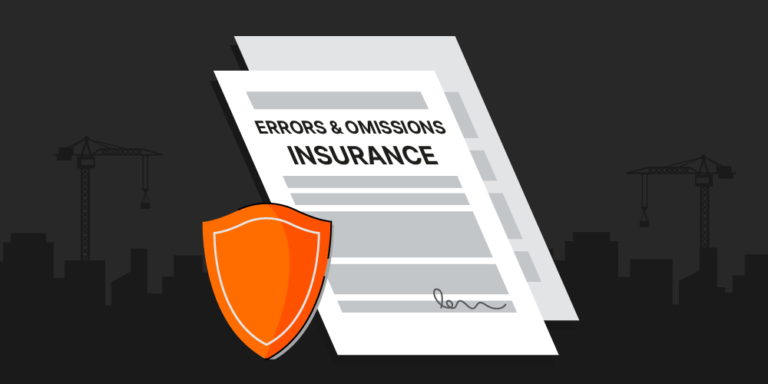— 7 min read
Errors and Omissions (E&O) Insurance Explained for Construction
Last Updated Oct 11, 2023

Errors and omissions (E&O) insurance covers contractors against financial loss resulting from mistakes, errors, or claims of negligence. While general liability insurance covers claims related to injury or property damage, errors and omissions insurance protects from lawsuits related to financial loss.
For example, an electrical contractor who failed to properly wire a building may cause a costly repair for the general contractor. However, E&O insurance would generally protect the electrician by covering attorney fees, settlements, and judgments.
Errors and omissions insurance, also called professional liability insurance, is one tool that contractors can use to transfer risk away from themselves. While E&O is not usually a legal requirement, many construction professionals take out an E&O policy to protect themselves against potentially devastating financial losses resulting from negligence.
Contents
Table of contents
What is errors and omissions insurance?
Errors and omissions insurance is a type of liability insurance that protects against claims related to professional negligence. Also referred to as professional liability insurance, E&O covers professionals when the services they provide lead to financial losses for a third party.
A construction contract creates a legal responsibility for the contractor to fulfill certain obligations to another party. When a contractor breaches that duty through an error or omission, professional liability insurance steps in to cover the financial loss caused. Unlike many types of insurance, E&O is a form of third-party insurance, because the policy provides restitution to cover another party’s financial losses rather than the policyholder’s.
In construction, many trades perform work that is complex and risky, which means nearly every contractor faces the possibility of a lawsuit for an error. Most states require contractors to hold general liability insurance while working on a job site, but that only protects against third-party injuries and property damage. Professional liability insurance can provide important additional coverage by handling claims of financial loss related to contracting services.
| Errors and Omissions (E&O) Insurance | |
|---|---|
| Definition | A type of professional liability insurance that protects against claims of financial loss resulting from negligence, errors, omissions, or misrepresentation |
| Type | Third-party |
| Coverage | Attorney fees, court costs, settlements, and judgments for claims made during the coverage period |
| Cost | Generally around 1% of annual revenue, but varies according to contractor specialty, geographical region, and claim history |
Errors and omissions vs. professional liability insurance
“Professional liability” is a newer term that emerged to highlight the fact that these policies often cover extra bells and whistles, like reputation, repair costs, travel costs, and subpoena coverage. However, errors and omissions insurance and professional liability insurance are identical, and the terms are used interchangeably in the construction industry.
Whether an insurance carrier uses the term errors and omissions or professional liability, contractors looking for this kind of coverage should be careful to review the entire policy to ensure it includes the services they need.
Related coverage – General Liability vs. Professional Liability: What’s the Difference?
Who needs E&O insurance?
Insurance covering errors and omissions exists for professionals in nearly every field — from accountants and lawyers to doctors and electricians. In construction, E&O policies exist for almost every trade and specialty, including:
- General contractors
- Masons
- Electricians
- Carpenters
- Concrete contractors
- Sheet metal contractors
- Painters
- Architects
- Engineers
- Home inspectors
State licensing boards often require architects, engineers, designers, and home inspectors to hold errors and omissions coverage. But nearly every contracting business can benefit from adding E&O to its slate of insurance policies. A single lawsuit related to professional negligence can financially ruin a contracting business. Maintaining adequate E&O coverage offers additional protection beyond what general liability insurance provides.

What does errors and omissions insurance cover?
In the most basic sense, all errors and omissions insurance coverage is similar, providing protection against claims that a professional’s services led to a financial loss. An E&O policy generally covers four common events:
- Errors made while performing services
- Omissions in completed work
- Negligence in work performed
- Incorrect professional advice provided
Simply put, an E&O policy covers contractors who make mistakes in the course of their work if they are liable for financial losses. However, coverage for specific events will vary significantly depending on the specific insurance policy and trade or specialty.
The scope of an errors and omissions policy varies depending on the trade or specialty. A policy will only cover a contractor for the scope of work they perform within their specialty, and trade-specific coverages and exclusions will typically be detailed throughout the policy. Usually, the detail of what trades are covered is included in the first pages of the policy, while important exceptions to coverage may come later in the list of forms.
For example, an E&O policy for electricians may have different coverages and exceptions than a policy drafted for a roofer, since the two trades perform different services. Therefore, it’s important to review a policy contract carefully to ensure that it has the coverage needed to protect a contracting business against potential lawsuits.
What E&O doesn't cover
Notably, errors and omissions insurance does not cover every situation that contractors may find themselves in professionally. For instance, while E&O usually covers negligence and mistakes, it does not cover illegal actions. Contractors are covered by E&O for a wide variety of mistakes, but violating the law will generally invalidate an insurance claim.
Events typically not covered by E&O insurance:
- Illegal actions, often regardless of intent
- Discrimination or harassment, which requires employee practices liability insurance
- Bodily injury or property damage, which is instead covered by general liability insurance
- Employee injury or illness, which is covered by workers’ compensation insurance, is typically a legal requirement of running a business
Outside of these very broad categories, a variety of exceptions may be included in a specific E&O contract depending on the insurance carrier and the trade or specialty, so reading the contract fully is paramount to ensure that necessary services are covered.
How much does an E&O policy cost?
A contractor can expect an E&O policy premium to cost approximately 1% of revenue. So a contractor with $1 million in annual revenue can expect to pay around $10,000 in E&O premiums.
However, the actual cost can vary widely depending on a variety of factors, including:
- Financial health
- Geographical region
- Trade or specialty
- Contract/project type
- Claim history
While the cost of an E&O policy is typically based on revenue, employee headcount may come into consideration in some cases. A policy underwriter will generally look at a contractor’s past and expected revenue, as well as the types of contracts a business usually signs. When an underwriter is looking at coverage limits and costs, the company’s financials typically dictate the policy cost.
Policy costs typically start with a base rate, which is then modified by factors like revenue as well as add-on coverages, lower deductibles, or higher coverage limits. In essence, the underwriter tries to determine a cost that anticipates the potential risks the contractor faces in the course of doing business.
What other insurance policies can contractors use?
Errors and omissions insurance is just a single piece of the insurance puzzle that helps contractors manage the risk associated with complex construction work. A variety of insurance policies — some legally required and others optional — serve as a form of risk transfer, meaning that they shift risk away from the contractor and onto insurance companies. While insurance costs may seem burdensome to many contracting businesses, the protection from damaging lawsuits and hefty settlements is ultimately worth it.
Some other forms of insurance that are key for construction businesses include:
- Subcontractor default insurance
- Inland marine insurance
With a proper insurance strategy, businesses will be able to stay in the green and maintain healthy cash flow even after incidents involving financial losses, injuries, or property damage.
Categories:
Tags:
Written by
Daniel Gray
27 articles
Daniel is an educator and writer with a speciality in construction. He has been writing construction content for Procore since 2022, and previously served as a Procore Content Manager before continuing to pursue an education career as an Assistant Headmaster for Valor Education in Austin. Daniel's experience writing for construction — as well as several clients under an agency — has broadened his knowledge and expertise across multiple subjects.
View profileExplore more helpful resources

Construction Underwriting: Assessing & Understanding Risk
When companies apply for construction insurance, construction underwriters are tasked with assessing risk and pricing policies accordingly. In the past, underwriters could only consider historical data, but as more contractors...

Subcontractor Default Insurance: SDI Policies Explained
Subcontractor default insurance (SDI) is a risk mitigation tool for general contractors to control subcontractor default risk. It protects GCs and upstream parties from subcontractors who default on contracts because...

Workers’ Compensation Insurance for Contractors
Workers’ compensation insurance is required for contractors with employees in most states. It covers injuries and illnesses that occur while workers are on the job — and may protect companies...

A Plumbing Contractor’s Guide to Insurance Coverage
Plumbing contractors should include business insurance as an integral part of their financial strategy. When you tackle the jobs you’ve secured, it’s also important to plan for the unexpected. With...
